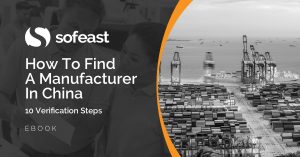I wrote before that the vast majority of Chinese manufacturers routinely subcontract some orders. The problem is, they usually do it without disclosing the reality to their customer.
Why do they subcontract production to another factory? Sometimes it is a necessity to meet the customer’s tight deadlines. And sometimes it is a way to cut costs, by placing production in a cheap workshop that has virtually no control over quality.
This can result in a quality disaster (very common), a PR disaster (if the goods are made in a prison, by kids, or in a place that burns down), and/or an IP rights disaster (when many factories are learning how to make your product and then start to sell it to anybody).
As a result, more and more companies made this practice forbidden. Think of Walmart and their “zero tolerance policy”, or Nike and their tough supplier contracts.
But how can your company prevent its Chinese suppliers from subcontracting?
I jotted down 8 ways below.
1. Work with the right people

This may sound a bit touchy-feely, but the factory owner(s)’s attitude is extremely important. If he is not motivated by your business and is very focused on his short-term financial needs, he will take short cuts. Even if the factory is large and very structured. Even if the owner is from Taiwan or Hong Kong. Make sure you are a good fit for the factory.
2. Know the factory’s capacity regarding your type of product
For example, a factory only has one line that can make your product and your order quantity will make it busy for 6 months. Or your peak buying season is the same as that of their other customers (e.g. they make BBQs for North America). This factory is probably not a good fit for you.
3. Don’t compress timelines in an unreasonable manner
If the factory needs 15 days to get all the components, and then 30 days for its own production, you can’t compress these lead times (unless, naturally, you show them how to plan and execute better). If you set a shipment date that can’t be pushed back and you hold production because some approvals are not finalized, you are placing the manufacturer in a position where they have to subcontract.
One useful tool is the production plan. You can request that your suppliers describe in an Excel file how many operators and how many machines will work on your order, for what daily output (if possible at the level of each process step), and for what ETD.
4. Challenge the reasons why they can’t produce faster
Very often, the owner wants to buy the parts from his friends/family. The better solution is to double- or triple-source the parts that have the longest order lead time.
Similarly, a simple value stream map exercise can show where the bottleneck(s) are located in their production. In many cases, elevating the bottlenecks is not complicated and not expensive. But the managers are often unaware of what holds their production numbers back!
5. Qualify and develop backup suppliers
If two manufacturers are ready to make your order, you have a good option in case your best choice is short in capacity. Get more information about reserve factories here.
6. Make use of legal tools
It is common to sign a contract that makes it forbidden to subcontract. If your contract is legally binding in China, and if some other customers don’t have such a contract, the manufacturer might think twice before subcontracting your order.
7. Monitor and enforce
Take advantage of inspections during production for two purposes:
- Checking quality and catching issues early
- Verifying that all production is taking place in approved facilities
For even stronger monitoring, conduct unannounced factory visits.
8. Keep an eye on production inputs
Do you direct the use of some suppliers? This is an opportunity to get information (through these sub-suppliers) on the rate of ordering and the delivery address(es). If you don’t want to manage your supply chain this way, you can do it easily with some labeling/packing materials.
—
What do you think? How have you had success with preventing Chinese suppliers from subcontracting out your products? Any issues or questions to share? Please comment and I’ll be happy to respond.
Disclaimer
We are not lawyers. What we wrote above is based only on our understanding of legal requirements. QualityInspection.org does not present this information as a basis for you to make decisions, and we do not accept any liability if you do so.
Are you wondering how to find a manufacturer in China who is well-suited to your needs and can also deliver on their promises?
Sofeast has developed 10 verification steps to help you find the right manufacturer. They’re shared in this FREE eBook: “How To Find A Manufacturer In China: 10 Verification Steps.”
It covers:
- Background checks
- Manufacturing capabilities
- Quality system auditing
- Engineering resources
- Pricing, negotiation, & contracts
- …and much, much more
Just hit the button below to get your copy:



I wanted to share my experience on sub-contracting. As to whether it was a positive or negative experience, I will leave it up to the reader to decide:
There was a factory we used a few years ago. We visited the factory before ordering and it was a sizable factory and audited and we saw our goods on the factory floor, so we were satisfied. We checked the goods before shipping our first shipment and they were within tolerance.
Starting with the second order, we only visited the factory to inspect goods before they shipped.
We worked with them for several years making variations of our products and shipping them with success.
One time we visited them on a friendly visit, and found that starting from our second shipment, they had sub-contracted out a major part of the manufacturing. They were open about it like it was common business.
They said that our first product was a perfect fit for their factory. But all subsequent variations that we ordered required completely different machinery. In fact, they had to sub-contract to a different factory each time because our product variations required specific machinery and most factories in the area were specialized in only one type of machine. They said that it was common place to sub-contract in that region because you can’t expect one factory to own every type of machinery in the world for making that class of product. The economy had evolved to the point that factories pooled their resources together to take orders because not one of them could make it alone.
I asked whether there were large factories that had carried most machines. The owner said, yes, but most of them closed down years ago because the operating overhead was too expensive during the slow season. The economy had evolved to be more nimble with pockets of expertise here and there.
As for the other large factories that were still in business, they will charge me several fold what I am currently paying for for my product, therefore they are only suitable for high-end brands.
Thanks for adding to the article. This is quite common, I believe.
Your company only worked on new product development, but not on new process development. This is a bit risky. You left a lot of decisions to be taken at the factory level. But fortunately it seems like it worked fine for you.
As to the justification that only ultra-specialized factories are cost competitive… Yes in China that’s mostly true. When there starts to be high complexity in the business, they seem to grow their central office staff exponentially, rather than having a few “focused factories” side by side.
Well-written and relevant piece, Renaud.
In my line of work, the unreasonable compression of timeline is a big culprit. Many quality issues and in the context of this post, subcontracting happens because of the client not allowing the factory the proper time required to do what’s necessary. Granted the factory doesn’t have to bend to the client’s rushing, but that’s a different matter…
Challenge the reasons is a good reminder (pt #4): managers view everything a series of disconnected steps and then I think the factory sometimes does not realize until it is too late that they have to pursue this subcontracting solution.
Oh yes, this is a huge problem in the promo items industry.
And you are right, the supplier often wonders “so, now, how do I make this order?” once the PO from the customer arrives. Not the best way to plan for production…